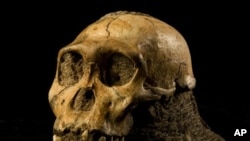Anthropologists analyzing the two-million-year-old fossilized teeth of an ape-like biped have determined the pre-human creatures probably ate a diet rich in fruits, nuts, leaves and tree bark. The surprising discovery suggests these human ancestors were more like forest-dwelling chimpanzees than savannah-strolling early humans.
Anthropologists examined two fossilized teeth from a creature called Australopithecus sediba, discovered in a cave in South Africa in 2008. The fossils belong to one of several extinct hominins, or ape-like species, believed to be relatives but not direct ancestors of homo sapiens - modern humans.
The small Australopithecus sediba, or A. sediba, walked upright, like homo sapiens, but had a face, small brain and long arms more like a chimpanzee. An analysis of material found in its fossilized teeth revealed the creature ate a very chimp-like diet of bark, twigs, nuts and berries.
Darryl de Ruiter, an associate professor of anthropology at Texas A & M University in College Station, was part of the international team that first excavated and examined the remains.
De Ruiter says anthropologists paid special attention to what remained of the sticky dental plaque still evident on the creature's teeth.
"It's that stuff, that plaque, that builds up on your teeth if you don't brush them regularly. And since these Australopiths did not brush their teeth, we have a fairly good record of preserved plant parts that were stuck in their teeth, that actually told us in very clear terms what they actually, physically put in their mouth and chewed on," De Ruiter said.
De Ruiter says documented diets of other Australopiths living on open grasslands and savannah-like areas show they had some forms of protein or meat in their diets. The researcher says it appears A. sediba is the first hominin to survive almost entirely on a forest-based diet, suggesting that it lived in a more wooded environment than previously thought.
"..things like nuts and leaves and berries, and even bark and other components of trees, that chimpanzees regularly, or at least occasionally, feed on. But we've never documented it before in Australopith," De Ruiter said.
However, de Ruiter doesn't rule out that A. sediba occasionally consumed asome protein in the form of insects or meat.
While Australopiths are related to modern humans in some way, discoveries about the creatures' diet could help clarify that lineage.
An article describing the forest-based diet of the early human ancestor, Australepithecus sediba, is published in the journal Nature.
Anthropologists examined two fossilized teeth from a creature called Australopithecus sediba, discovered in a cave in South Africa in 2008. The fossils belong to one of several extinct hominins, or ape-like species, believed to be relatives but not direct ancestors of homo sapiens - modern humans.
The small Australopithecus sediba, or A. sediba, walked upright, like homo sapiens, but had a face, small brain and long arms more like a chimpanzee. An analysis of material found in its fossilized teeth revealed the creature ate a very chimp-like diet of bark, twigs, nuts and berries.
Darryl de Ruiter, an associate professor of anthropology at Texas A & M University in College Station, was part of the international team that first excavated and examined the remains.
De Ruiter says anthropologists paid special attention to what remained of the sticky dental plaque still evident on the creature's teeth.
"It's that stuff, that plaque, that builds up on your teeth if you don't brush them regularly. And since these Australopiths did not brush their teeth, we have a fairly good record of preserved plant parts that were stuck in their teeth, that actually told us in very clear terms what they actually, physically put in their mouth and chewed on," De Ruiter said.
De Ruiter says documented diets of other Australopiths living on open grasslands and savannah-like areas show they had some forms of protein or meat in their diets. The researcher says it appears A. sediba is the first hominin to survive almost entirely on a forest-based diet, suggesting that it lived in a more wooded environment than previously thought.
"..things like nuts and leaves and berries, and even bark and other components of trees, that chimpanzees regularly, or at least occasionally, feed on. But we've never documented it before in Australopith," De Ruiter said.
However, de Ruiter doesn't rule out that A. sediba occasionally consumed asome protein in the form of insects or meat.
While Australopiths are related to modern humans in some way, discoveries about the creatures' diet could help clarify that lineage.
An article describing the forest-based diet of the early human ancestor, Australepithecus sediba, is published in the journal Nature.





